Counter Surveillance Report
VerifiedAdded on 2020/02/24
|7
|1266
|95
Report
AI Summary
This report comprehensively examines counter surveillance, defining the concept and its various applications across government, criminal, and business sectors. It details several methods of surveillance, including computer surveillance (data and internet traffic monitoring), camera surveillance, telephone tapping, social network analysis, and biometric surveillance. The report further delves into team surveillance techniques, highlighting their effectiveness and the specialized training required. The included references suggest a focus on academic research and understanding of the technological and societal implications of surveillance.
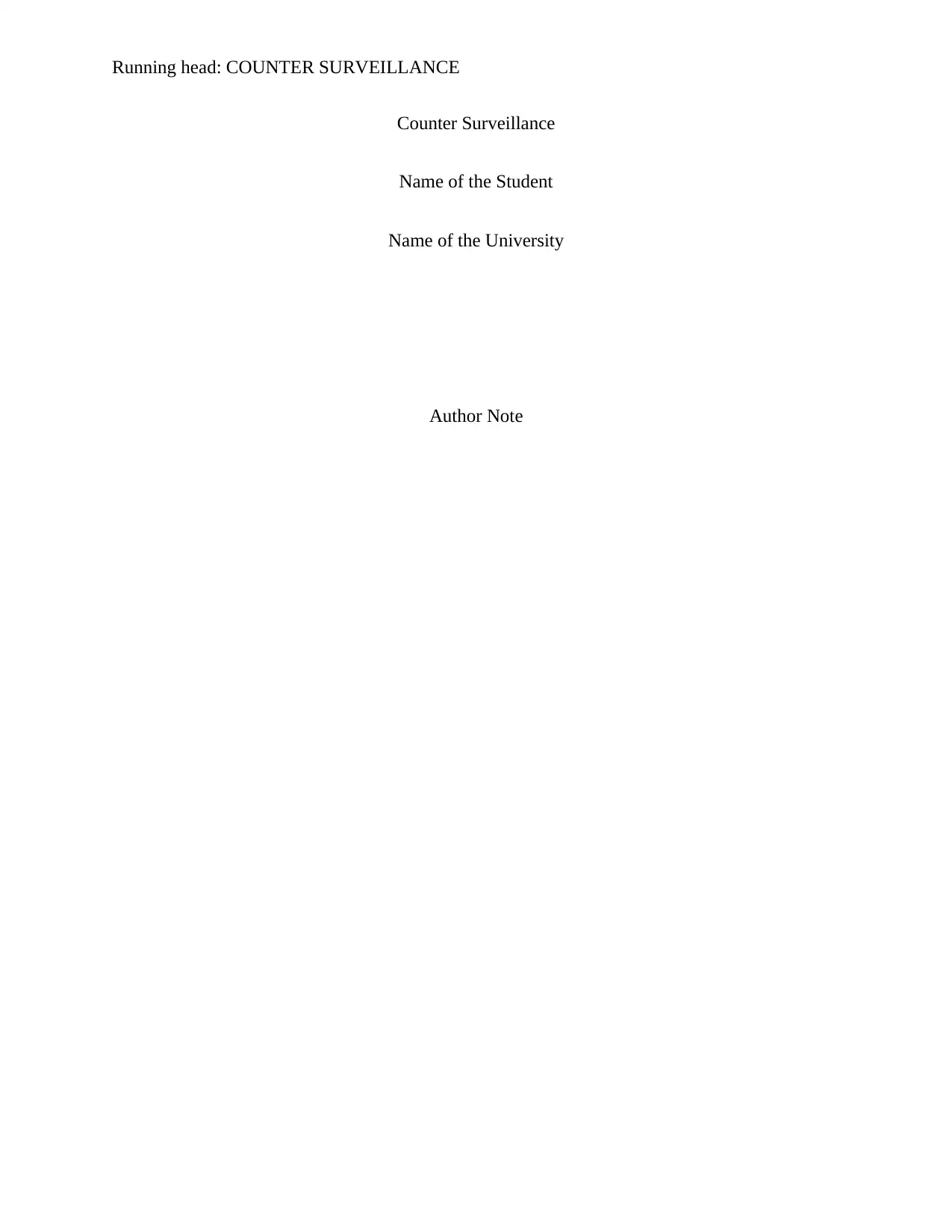
Running head: COUNTER SURVEILLANCE
Counter Surveillance
Name of the Student
Name of the University
Author Note
Counter Surveillance
Name of the Student
Name of the University
Author Note
Paraphrase This Document
Need a fresh take? Get an instant paraphrase of this document with our AI Paraphraser
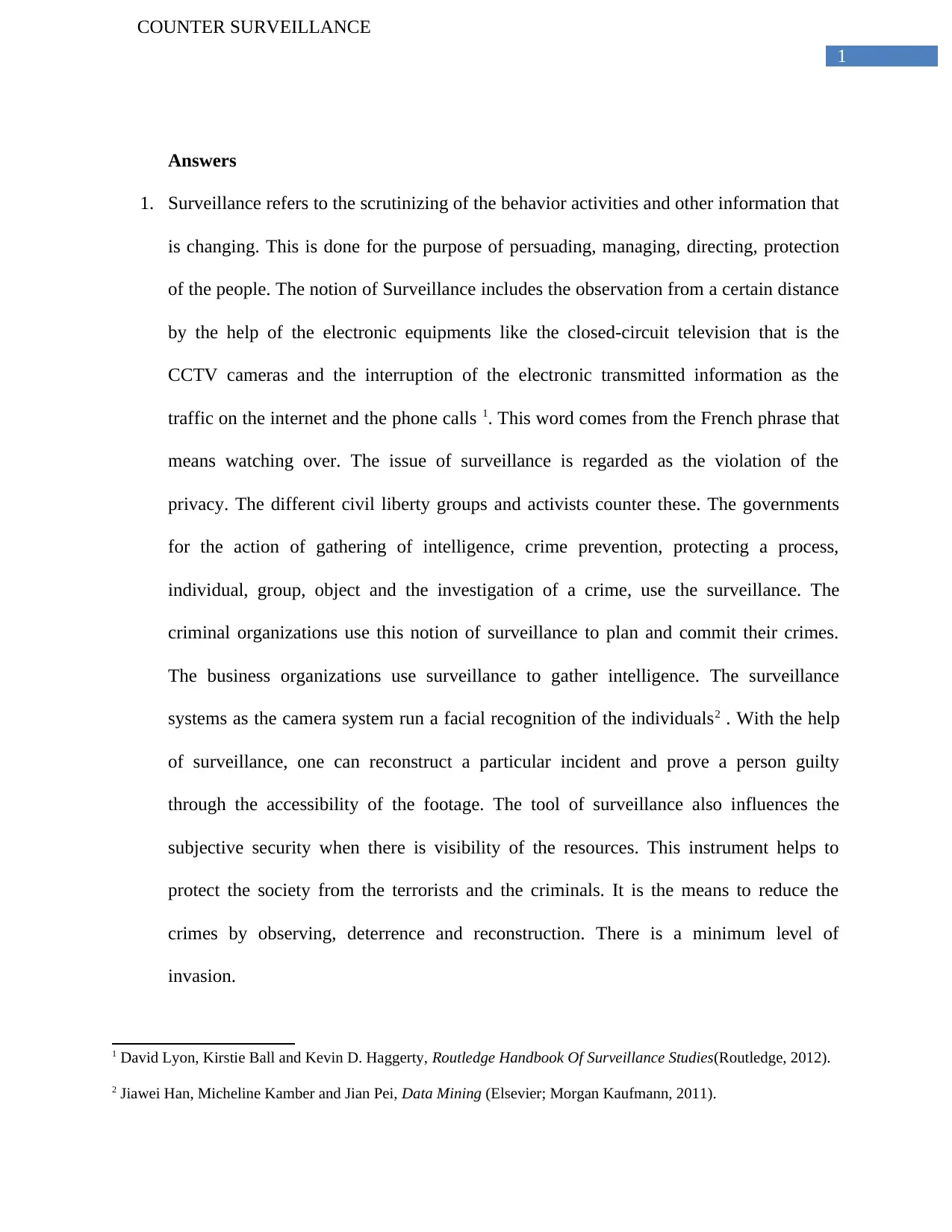
1
COUNTER SURVEILLANCE
Answers
1. Surveillance refers to the scrutinizing of the behavior activities and other information that
is changing. This is done for the purpose of persuading, managing, directing, protection
of the people. The notion of Surveillance includes the observation from a certain distance
by the help of the electronic equipments like the closed-circuit television that is the
CCTV cameras and the interruption of the electronic transmitted information as the
traffic on the internet and the phone calls 1. This word comes from the French phrase that
means watching over. The issue of surveillance is regarded as the violation of the
privacy. The different civil liberty groups and activists counter these. The governments
for the action of gathering of intelligence, crime prevention, protecting a process,
individual, group, object and the investigation of a crime, use the surveillance. The
criminal organizations use this notion of surveillance to plan and commit their crimes.
The business organizations use surveillance to gather intelligence. The surveillance
systems as the camera system run a facial recognition of the individuals2 . With the help
of surveillance, one can reconstruct a particular incident and prove a person guilty
through the accessibility of the footage. The tool of surveillance also influences the
subjective security when there is visibility of the resources. This instrument helps to
protect the society from the terrorists and the criminals. It is the means to reduce the
crimes by observing, deterrence and reconstruction. There is a minimum level of
invasion.
1 David Lyon, Kirstie Ball and Kevin D. Haggerty, Routledge Handbook Of Surveillance Studies(Routledge, 2012).
2 Jiawei Han, Micheline Kamber and Jian Pei, Data Mining (Elsevier; Morgan Kaufmann, 2011).
COUNTER SURVEILLANCE
Answers
1. Surveillance refers to the scrutinizing of the behavior activities and other information that
is changing. This is done for the purpose of persuading, managing, directing, protection
of the people. The notion of Surveillance includes the observation from a certain distance
by the help of the electronic equipments like the closed-circuit television that is the
CCTV cameras and the interruption of the electronic transmitted information as the
traffic on the internet and the phone calls 1. This word comes from the French phrase that
means watching over. The issue of surveillance is regarded as the violation of the
privacy. The different civil liberty groups and activists counter these. The governments
for the action of gathering of intelligence, crime prevention, protecting a process,
individual, group, object and the investigation of a crime, use the surveillance. The
criminal organizations use this notion of surveillance to plan and commit their crimes.
The business organizations use surveillance to gather intelligence. The surveillance
systems as the camera system run a facial recognition of the individuals2 . With the help
of surveillance, one can reconstruct a particular incident and prove a person guilty
through the accessibility of the footage. The tool of surveillance also influences the
subjective security when there is visibility of the resources. This instrument helps to
protect the society from the terrorists and the criminals. It is the means to reduce the
crimes by observing, deterrence and reconstruction. There is a minimum level of
invasion.
1 David Lyon, Kirstie Ball and Kevin D. Haggerty, Routledge Handbook Of Surveillance Studies(Routledge, 2012).
2 Jiawei Han, Micheline Kamber and Jian Pei, Data Mining (Elsevier; Morgan Kaufmann, 2011).
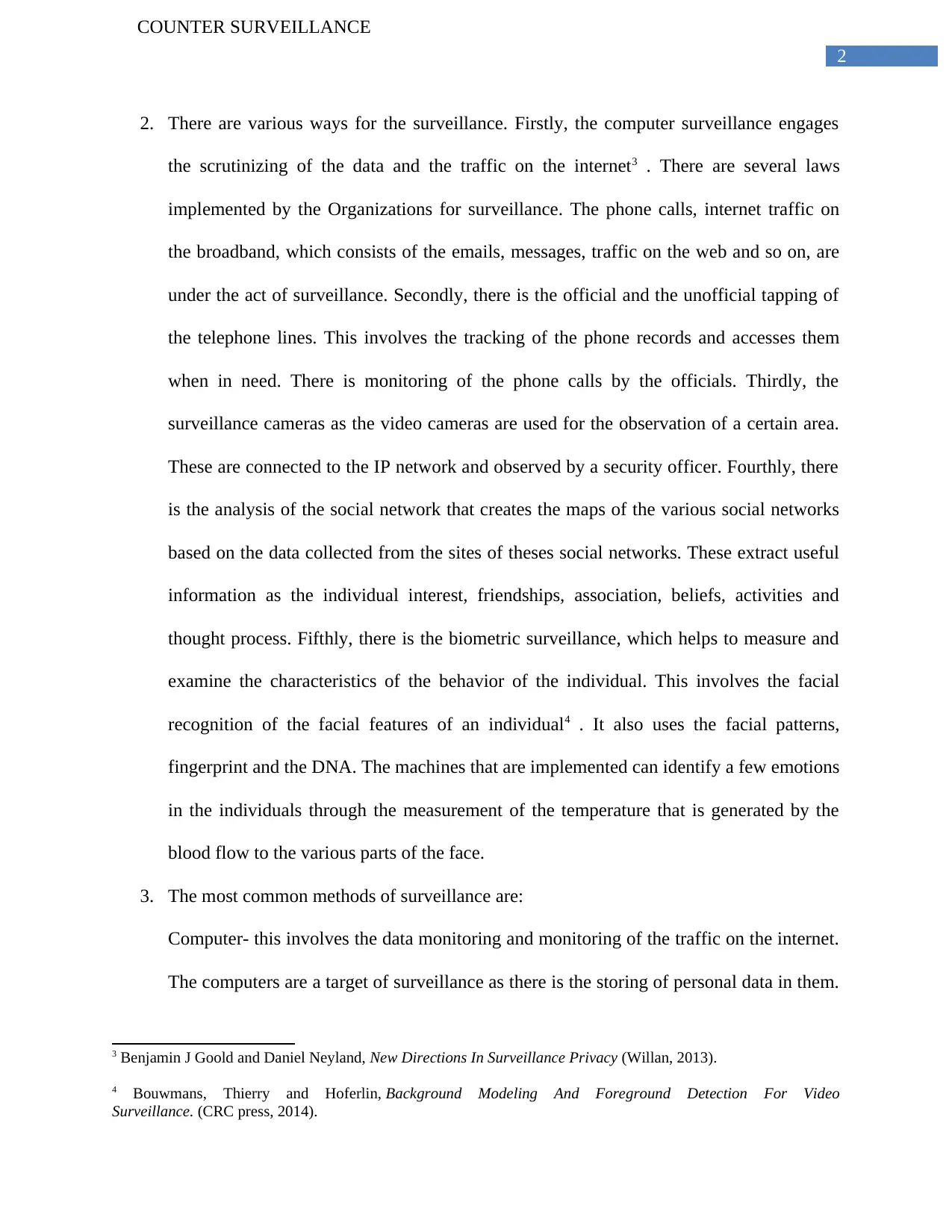
2
COUNTER SURVEILLANCE
2. There are various ways for the surveillance. Firstly, the computer surveillance engages
the scrutinizing of the data and the traffic on the internet3 . There are several laws
implemented by the Organizations for surveillance. The phone calls, internet traffic on
the broadband, which consists of the emails, messages, traffic on the web and so on, are
under the act of surveillance. Secondly, there is the official and the unofficial tapping of
the telephone lines. This involves the tracking of the phone records and accesses them
when in need. There is monitoring of the phone calls by the officials. Thirdly, the
surveillance cameras as the video cameras are used for the observation of a certain area.
These are connected to the IP network and observed by a security officer. Fourthly, there
is the analysis of the social network that creates the maps of the various social networks
based on the data collected from the sites of theses social networks. These extract useful
information as the individual interest, friendships, association, beliefs, activities and
thought process. Fifthly, there is the biometric surveillance, which helps to measure and
examine the characteristics of the behavior of the individual. This involves the facial
recognition of the facial features of an individual4 . It also uses the facial patterns,
fingerprint and the DNA. The machines that are implemented can identify a few emotions
in the individuals through the measurement of the temperature that is generated by the
blood flow to the various parts of the face.
3. The most common methods of surveillance are:
Computer- this involves the data monitoring and monitoring of the traffic on the internet.
The computers are a target of surveillance as there is the storing of personal data in them.
3 Benjamin J Goold and Daniel Neyland, New Directions In Surveillance Privacy (Willan, 2013).
4 Bouwmans, Thierry and Hoferlin, Background Modeling And Foreground Detection For Video
Surveillance. (CRC press, 2014).
COUNTER SURVEILLANCE
2. There are various ways for the surveillance. Firstly, the computer surveillance engages
the scrutinizing of the data and the traffic on the internet3 . There are several laws
implemented by the Organizations for surveillance. The phone calls, internet traffic on
the broadband, which consists of the emails, messages, traffic on the web and so on, are
under the act of surveillance. Secondly, there is the official and the unofficial tapping of
the telephone lines. This involves the tracking of the phone records and accesses them
when in need. There is monitoring of the phone calls by the officials. Thirdly, the
surveillance cameras as the video cameras are used for the observation of a certain area.
These are connected to the IP network and observed by a security officer. Fourthly, there
is the analysis of the social network that creates the maps of the various social networks
based on the data collected from the sites of theses social networks. These extract useful
information as the individual interest, friendships, association, beliefs, activities and
thought process. Fifthly, there is the biometric surveillance, which helps to measure and
examine the characteristics of the behavior of the individual. This involves the facial
recognition of the facial features of an individual4 . It also uses the facial patterns,
fingerprint and the DNA. The machines that are implemented can identify a few emotions
in the individuals through the measurement of the temperature that is generated by the
blood flow to the various parts of the face.
3. The most common methods of surveillance are:
Computer- this involves the data monitoring and monitoring of the traffic on the internet.
The computers are a target of surveillance as there is the storing of personal data in them.
3 Benjamin J Goold and Daniel Neyland, New Directions In Surveillance Privacy (Willan, 2013).
4 Bouwmans, Thierry and Hoferlin, Background Modeling And Foreground Detection For Video
Surveillance. (CRC press, 2014).
⊘ This is a preview!⊘
Do you want full access?
Subscribe today to unlock all pages.

Trusted by 1+ million students worldwide
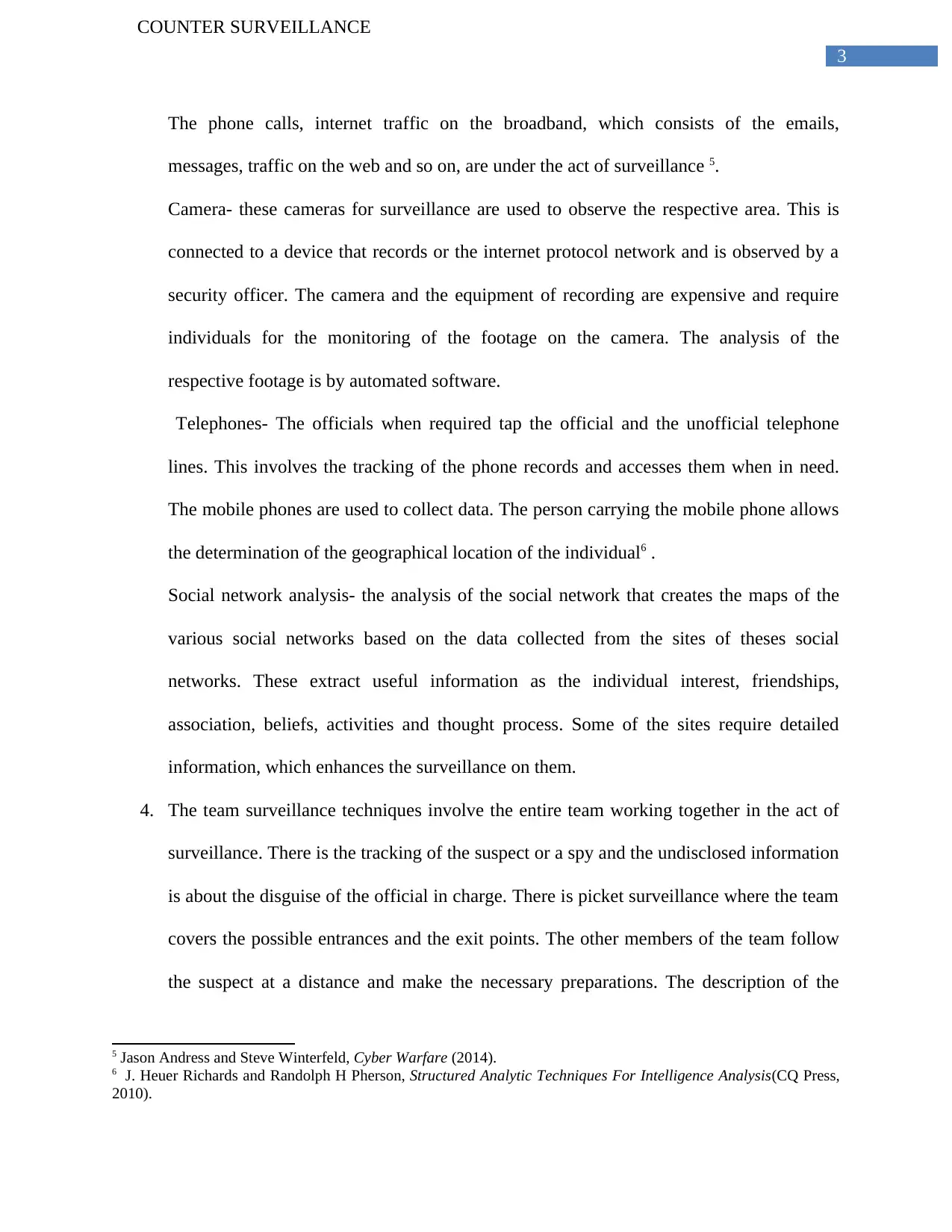
3
COUNTER SURVEILLANCE
The phone calls, internet traffic on the broadband, which consists of the emails,
messages, traffic on the web and so on, are under the act of surveillance 5.
Camera- these cameras for surveillance are used to observe the respective area. This is
connected to a device that records or the internet protocol network and is observed by a
security officer. The camera and the equipment of recording are expensive and require
individuals for the monitoring of the footage on the camera. The analysis of the
respective footage is by automated software.
Telephones- The officials when required tap the official and the unofficial telephone
lines. This involves the tracking of the phone records and accesses them when in need.
The mobile phones are used to collect data. The person carrying the mobile phone allows
the determination of the geographical location of the individual6 .
Social network analysis- the analysis of the social network that creates the maps of the
various social networks based on the data collected from the sites of theses social
networks. These extract useful information as the individual interest, friendships,
association, beliefs, activities and thought process. Some of the sites require detailed
information, which enhances the surveillance on them.
4. The team surveillance techniques involve the entire team working together in the act of
surveillance. There is the tracking of the suspect or a spy and the undisclosed information
is about the disguise of the official in charge. There is picket surveillance where the team
covers the possible entrances and the exit points. The other members of the team follow
the suspect at a distance and make the necessary preparations. The description of the
5 Jason Andress and Steve Winterfeld, Cyber Warfare (2014).
6 J. Heuer Richards and Randolph H Pherson, Structured Analytic Techniques For Intelligence Analysis(CQ Press,
2010).
COUNTER SURVEILLANCE
The phone calls, internet traffic on the broadband, which consists of the emails,
messages, traffic on the web and so on, are under the act of surveillance 5.
Camera- these cameras for surveillance are used to observe the respective area. This is
connected to a device that records or the internet protocol network and is observed by a
security officer. The camera and the equipment of recording are expensive and require
individuals for the monitoring of the footage on the camera. The analysis of the
respective footage is by automated software.
Telephones- The officials when required tap the official and the unofficial telephone
lines. This involves the tracking of the phone records and accesses them when in need.
The mobile phones are used to collect data. The person carrying the mobile phone allows
the determination of the geographical location of the individual6 .
Social network analysis- the analysis of the social network that creates the maps of the
various social networks based on the data collected from the sites of theses social
networks. These extract useful information as the individual interest, friendships,
association, beliefs, activities and thought process. Some of the sites require detailed
information, which enhances the surveillance on them.
4. The team surveillance techniques involve the entire team working together in the act of
surveillance. There is the tracking of the suspect or a spy and the undisclosed information
is about the disguise of the official in charge. There is picket surveillance where the team
covers the possible entrances and the exit points. The other members of the team follow
the suspect at a distance and make the necessary preparations. The description of the
5 Jason Andress and Steve Winterfeld, Cyber Warfare (2014).
6 J. Heuer Richards and Randolph H Pherson, Structured Analytic Techniques For Intelligence Analysis(CQ Press,
2010).
Paraphrase This Document
Need a fresh take? Get an instant paraphrase of this document with our AI Paraphraser
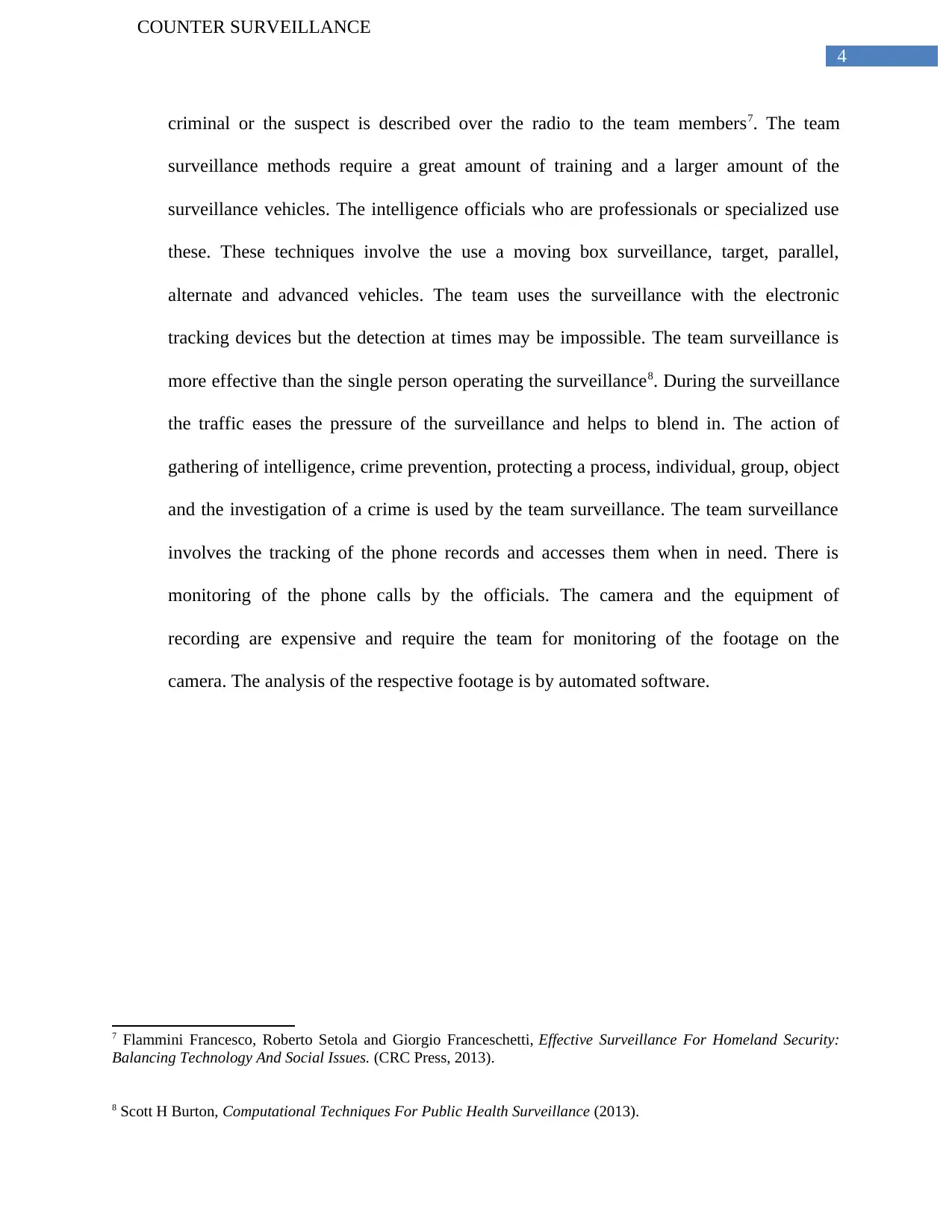
4
COUNTER SURVEILLANCE
criminal or the suspect is described over the radio to the team members7. The team
surveillance methods require a great amount of training and a larger amount of the
surveillance vehicles. The intelligence officials who are professionals or specialized use
these. These techniques involve the use a moving box surveillance, target, parallel,
alternate and advanced vehicles. The team uses the surveillance with the electronic
tracking devices but the detection at times may be impossible. The team surveillance is
more effective than the single person operating the surveillance8. During the surveillance
the traffic eases the pressure of the surveillance and helps to blend in. The action of
gathering of intelligence, crime prevention, protecting a process, individual, group, object
and the investigation of a crime is used by the team surveillance. The team surveillance
involves the tracking of the phone records and accesses them when in need. There is
monitoring of the phone calls by the officials. The camera and the equipment of
recording are expensive and require the team for monitoring of the footage on the
camera. The analysis of the respective footage is by automated software.
7 Flammini Francesco, Roberto Setola and Giorgio Franceschetti, Effective Surveillance For Homeland Security:
Balancing Technology And Social Issues. (CRC Press, 2013).
8 Scott H Burton, Computational Techniques For Public Health Surveillance (2013).
COUNTER SURVEILLANCE
criminal or the suspect is described over the radio to the team members7. The team
surveillance methods require a great amount of training and a larger amount of the
surveillance vehicles. The intelligence officials who are professionals or specialized use
these. These techniques involve the use a moving box surveillance, target, parallel,
alternate and advanced vehicles. The team uses the surveillance with the electronic
tracking devices but the detection at times may be impossible. The team surveillance is
more effective than the single person operating the surveillance8. During the surveillance
the traffic eases the pressure of the surveillance and helps to blend in. The action of
gathering of intelligence, crime prevention, protecting a process, individual, group, object
and the investigation of a crime is used by the team surveillance. The team surveillance
involves the tracking of the phone records and accesses them when in need. There is
monitoring of the phone calls by the officials. The camera and the equipment of
recording are expensive and require the team for monitoring of the footage on the
camera. The analysis of the respective footage is by automated software.
7 Flammini Francesco, Roberto Setola and Giorgio Franceschetti, Effective Surveillance For Homeland Security:
Balancing Technology And Social Issues. (CRC Press, 2013).
8 Scott H Burton, Computational Techniques For Public Health Surveillance (2013).
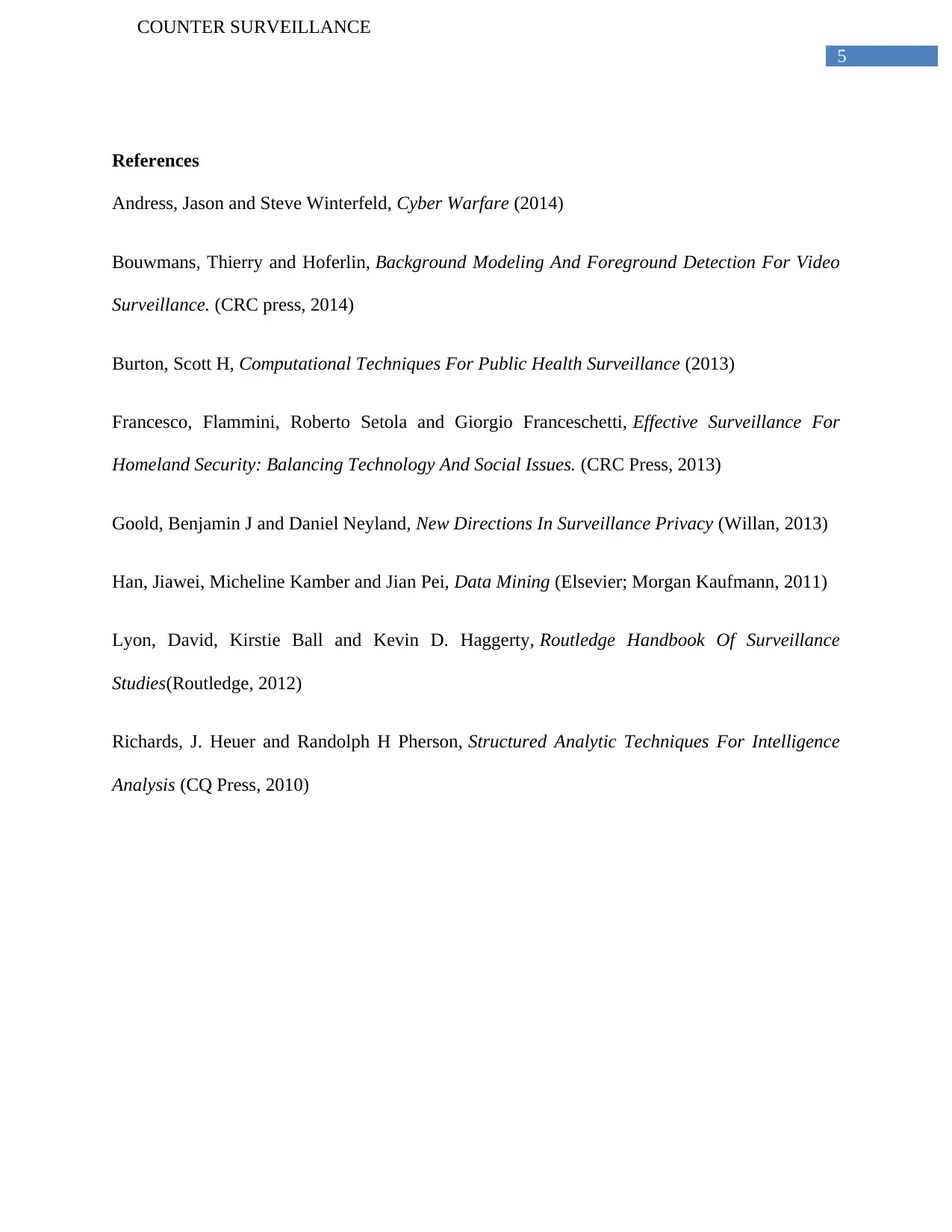
5
COUNTER SURVEILLANCE
References
Andress, Jason and Steve Winterfeld, Cyber Warfare (2014)
Bouwmans, Thierry and Hoferlin, Background Modeling And Foreground Detection For Video
Surveillance. (CRC press, 2014)
Burton, Scott H, Computational Techniques For Public Health Surveillance (2013)
Francesco, Flammini, Roberto Setola and Giorgio Franceschetti, Effective Surveillance For
Homeland Security: Balancing Technology And Social Issues. (CRC Press, 2013)
Goold, Benjamin J and Daniel Neyland, New Directions In Surveillance Privacy (Willan, 2013)
Han, Jiawei, Micheline Kamber and Jian Pei, Data Mining (Elsevier; Morgan Kaufmann, 2011)
Lyon, David, Kirstie Ball and Kevin D. Haggerty, Routledge Handbook Of Surveillance
Studies(Routledge, 2012)
Richards, J. Heuer and Randolph H Pherson, Structured Analytic Techniques For Intelligence
Analysis (CQ Press, 2010)
COUNTER SURVEILLANCE
References
Andress, Jason and Steve Winterfeld, Cyber Warfare (2014)
Bouwmans, Thierry and Hoferlin, Background Modeling And Foreground Detection For Video
Surveillance. (CRC press, 2014)
Burton, Scott H, Computational Techniques For Public Health Surveillance (2013)
Francesco, Flammini, Roberto Setola and Giorgio Franceschetti, Effective Surveillance For
Homeland Security: Balancing Technology And Social Issues. (CRC Press, 2013)
Goold, Benjamin J and Daniel Neyland, New Directions In Surveillance Privacy (Willan, 2013)
Han, Jiawei, Micheline Kamber and Jian Pei, Data Mining (Elsevier; Morgan Kaufmann, 2011)
Lyon, David, Kirstie Ball and Kevin D. Haggerty, Routledge Handbook Of Surveillance
Studies(Routledge, 2012)
Richards, J. Heuer and Randolph H Pherson, Structured Analytic Techniques For Intelligence
Analysis (CQ Press, 2010)
⊘ This is a preview!⊘
Do you want full access?
Subscribe today to unlock all pages.

Trusted by 1+ million students worldwide
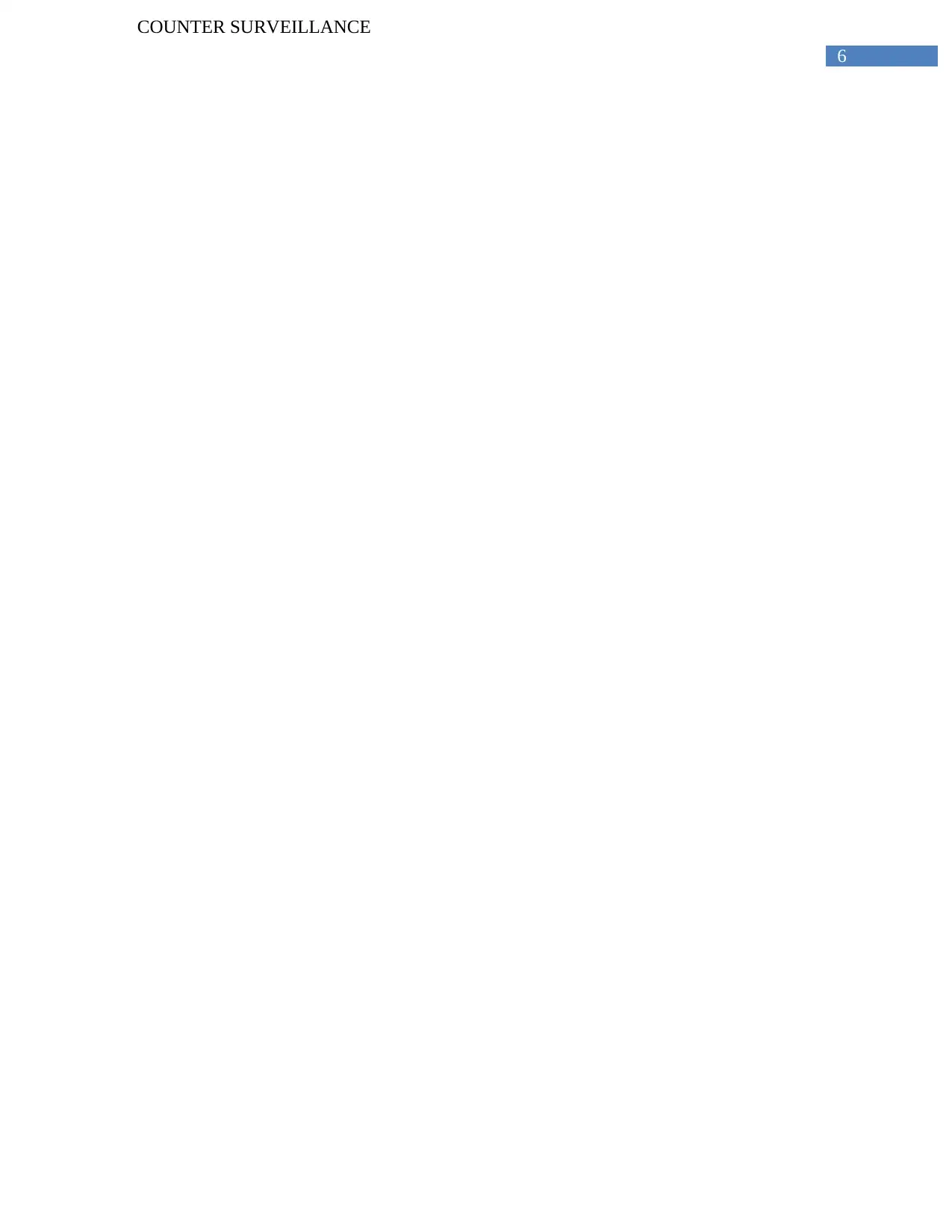
6
COUNTER SURVEILLANCE
COUNTER SURVEILLANCE
1 out of 7
Related Documents
Your All-in-One AI-Powered Toolkit for Academic Success.
+13062052269
info@desklib.com
Available 24*7 on WhatsApp / Email
![[object Object]](/_next/static/media/star-bottom.7253800d.svg)
Unlock your academic potential
Copyright © 2020–2025 A2Z Services. All Rights Reserved. Developed and managed by ZUCOL.




